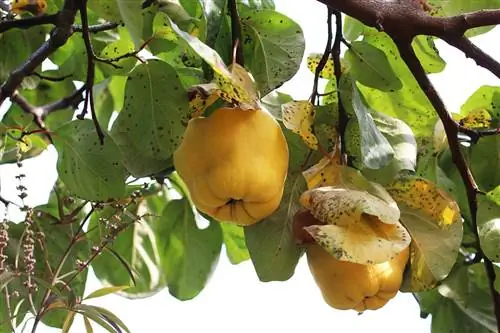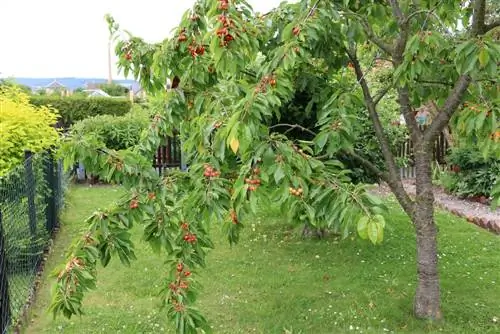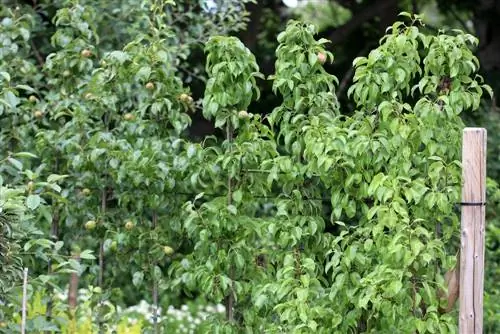- Author admin [email protected].
- Public 2023-12-17 03:39.
- Last modified 2025-06-01 06:48.
Tall, old fruit trees conjure up a special charm in every garden. But they usually not only make a lot of dirt, but also take up space. This is not available to everyone. Dwarf fruit and columnar fruit trees offer a perfect alternative here, although they differ in some respects from their larger counterparts in terms of the care they require. Expert tips ensure that your specimen develops splendidly.
Tip for location
Whether bushy or slender growing in a column, small fruit trees take up little space. Especially when they are cultivated in pots, they fit even on the smallest balcony. However, the location is not optimal and means that you have to pay more attention to the plant when caring for it. If you plant a dwarf fruit tree in the garden bed, it does not require any more care than a normal, large fruit tree of the same type.
Otherwise, the following location characteristics are sufficient for planted and cultivated dwarf fruit trees:
- Nutritious soil
- Sunny place
Best planting time
For hardy small fruit trees, the best season for planting is autumn. They can settle well by spring and start growing right away the next season. Young plants should be provided with winter protection over the winter. (See also: Tips for proper wintering)
Tips for Cultivation

When planting in a container, a few factors should be taken into account so that small fruit trees grow strong, he althy and produce a good harvest.
Pot/container size
For small fruit trees, it is very important that their roots can spread unhindered. For this reason, it is recommended to choose a pot that is around 30 liters in size. Basically, the bigger the pot/bucket, the better the plant can develop.
Pot/Bucket Features
Only use a pot/pot that has a drainage hole. Excess irrigation and rain water can drain off through this. In this way, the formation of waterlogging can be prevented, which quickly causes small fruit trees to become sick and negatively affects fruit production.
Drainage
On the bottom of the pot/bucket, a two to five centimeter high layer of gravel, quartz sand or clay shards ensures drainage. This also reduces the risk of waterlogging.
potting soil
While fruit trees in the garden generally do not place great demands on the soil quality, for small fruit trees in pots/buckets this should meet several conditions. This is because the roots of outdoor trees can sustain themselves from the soil to a much greater extent. With potted plants, they rely on what you provide them. The following tips should be taken into account when soiling pots and containers:
- Mix of conventional potting soil, high-quality substrate and a little sand
- Particularly nutrient-rich
- Horn shavings improve the long-term supply of nutrients
- Incorporated bark mulch allows the soil to dry out more slowly
Tips for repotting small fruit trees
Frequency
A small fruit tree should be repotted into completely fresh soil every three to five years. A slender-growing columnar fruit tree is repotted about every four years. The prerequisite is that the plants have enough space in the old pot/bucket by then. If this is not the case or if an illness makes repotting necessary, this is of course preferable. Replacing the top layer of soil once a year is beneficial.
Cutting roots
Repotting is the ideal time to cut the roots of a small fruit tree. Pruning is recommended because it strengthens the roots and allows them to continue growing vigorously. But be careful, because too much root pruning can affect the crown design. A few centimeters are sufficient. Above all, excessive pruning of thick roots should be avoided. Here you should only cut off the tips. Root pruning works best when there is a distance of between three and five centimeters from the pot/pot in all directions.
Tips for watering small fruit trees
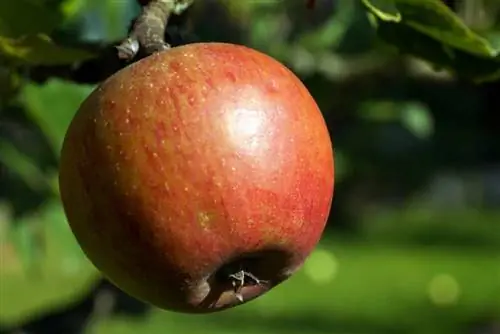
A small fruit tree dries much more quickly in a pot than in the garden soil, where it may be next to shade-providing plants that keep the soil environment more moist overall. For this reason, the cultivated fruit tree usually has a noticeably higher water requirement. A daily check is mandatory in summer, as drying out of the small specimens can quickly lead to drying out and this can have a serious impact on growth. To find out the right moment to water, you can do the following:
- Keep your fingers in the ground
- Can it be pressed in less than two centimeters - watering requirements
- If it can be pressed in more than two centimeters - no watering required
Tips for fertilizing small fruit trees
Garden trees in the ground do not need to be fertilized often. A little compost every spring supports he althy growth.
For potted plants, however, fertilizing is advisable, as described below:
- March/April fertilization with special fruit fertilizer
- Refertilize in June
- Under no circumstances should you fertilize later than August, otherwise the woodiness in autumn may not be ideal
Tips for Pruning Small Fruit Trees
Dwarf fruit trees
In contrast to their larger counterparts, dwarf fruit trees are cut more frequently and shorter. Various suitable pruning techniques relate to those of the traditional fruit tree and are similar to those used in bonsai care.
- The first cut is always done shortly before budding
- Prune regularly all branches that cross, parallel or do not grow outwards (encourages dense growth and harvest)
- Always cut above buds - never between two buds (increases the risk of infection)
- Do not prune the lower crown area at first (ensures thicker branches)
- Last cut in August at the latest, so that the hardening of the wood works optimally in autumn
- Close cuts with carbon powder or special wound resin from specialist retailers
Columnar fruit trees
Unlike dwarf fruit trees, these require significantly less pruning. They generally maintain their slim shape. If cutting is still necessary, follow the following instructions:
- Cut shoots back to a maximum length of ten centimeters
- Short the middle shoot to the desired height if it is too tall
- Cut only in summer and/or winter
Tips for proper wintering
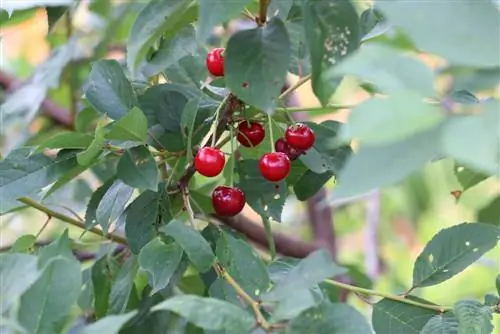
The small versions of normal fruit trees in German gardens are usually just as hardy as their larger relatives. Whether plums, cherries or apples, they do not need any special winter protection, even in small format, as long as they are planted in the garden soil. Things can look different with specimens that are cultivated in a bucket. Here the winter cold has a significantly greater effect on the trees, which increases the risk of frostbite. That's why you should either plant your fruit tree in the garden bed in early autumn or make special preparations for the potted plant, such as
- Never place the bucket directly on the cold floor, but place an insulating layer of Styrofoam or wood between them
- Place in a location protected from the wind
- A light rain cover under a canopy is ideal so that the earth doesn't freeze completely when frost hits
- Cover the bucket with jute or thick plastic film in freezing temperatures
- Place straw, brushwood or leaves in the bucket to cover the root area
- Always protect young plants in winter with plant fleece or brushwood
- Or, as an alternative to the winter measures, move to a bright winter quarters with temperatures around freezing point
Tips on diseases and pests
Root rot
Fruit trees are quite robust against diseases and pests, even when they are small or slender. However, specimens in pots have a higher risk of waterlogging, which can quickly lead to root rot. A musty smell rising from the soil, drooping, yellow leaves, loss of shoot stability and falling buds are typical signs of root rot. If you recognize these quickly enough, you have a good chance of being able to save your fruit tree with the following tip:
- Punt the plant immediately
- Free the roots from the damp soil as much as possible
- Place the roots in a dry, bright place, but not in direct sun or on a heat source
- After about a day, cut particularly soft root parts back to the harder area
- Mouldy root parts must be completely trimmed
- On the remaining roots, just slightly cut off the tips by two to three centimeters
- Then plant back into the pot with fresh, dry soil
- Only water lightly and only cover minimal water requirements for seven to ten days
- After 14 days, if necessary, prune the fruit tree a little
Aphids
Aphids can become a real pest even on small fruit trees. The black, brownish or greenish parasites can usually be recognized by the way they form colonies on the stems. A sticky coating (honeydew) forms on the leaves, which is caused by the excretions. They suck the plant sap from the leaves, which yellow, wither and dry out. In any case, an untreated aphid infestation is associated with losses in the harvest. Combating it is easy to do with a home remedy:
- Make a highly concentrated soap solution
- Use a soap without additives (neutral or soft soap)
- Pour the lye into a spray pump
- Spray the plant dripping wet from all directions and under the leaves
- If necessary, repeat the process after a few days
- Afterwards, spray the plants well with clean water when there are no more aphids


